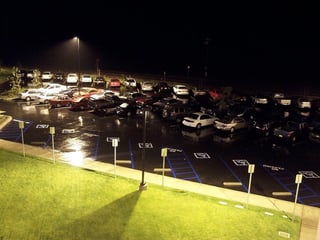 Many current outdooor parking lot lighting systems are outdated. If you are running High-Pressure Sodium lights in your parking lot, that is a definite sign that your system is outdated, which means that you're most likely overspending on electricity and possibly lack lighting controls that could be saving you money.
Many current outdooor parking lot lighting systems are outdated. If you are running High-Pressure Sodium lights in your parking lot, that is a definite sign that your system is outdated, which means that you're most likely overspending on electricity and possibly lack lighting controls that could be saving you money.
By now, it’s widely accepted the LED lights have better color, lifetime and efficiency than older High-Pressure Sodium lights. LEDs have are used for most lighting of parking lots today. If you have a lot that needs an overhaul consider making the switch to LEDs with a parking lot lighting control upgrade to save money on energy costs.
Not sure what to look for in your new system? Consider these features for your new lights and parking lot lighting control upgrade.
1. Intelligent Lighting Design Systems
Newer technology has meant that business owners can have a lot more power over their lighting set-ups. In the past, most lighting was controlled by standalone systems. They are easy to install, but often work autonomously, with one light being connected to a nearby sensor. There was no outside control. Although these can work in some situations, an intelligent design system is often a better choice.
An intelligent lighting design connects all sensors and lights within an entire system through an secure network. This gives you a platform that can monitor and control all of the areas you need. These are especially common inside warehouses, or in a situation where lighting should be dynamically adjusted to fit a need.
2. Lighting Sensors vs. Manual Light Switches
Occupancy sensing is become much more popular with green initiatives. An occupancy sensor will automatically shut off a light when there is nobody in a designated area.
In all situations, occupancy sensing will save energy compared to manual on-off switches. In the case of parking lots, it is never particularly safe to completely shut off the lights for any amount of time, which is where bi-level lighting comes into the equation.
3. Bi-Level Parking Lot Lighting
Obviously, the main reason that you want to have your parking lot lights shining brightly at night is for safety. If you still have a few cars in the lot overnight, or especially if you want to increase your car dealership curb appeal, you don’t want them to be in the dark. Because of this, most parking lot lights flip on at sunset, and stay on high-power until dawn.
This isn’t necessary, and wastes a lot of money. Motion sensors are now being used to help parking lots save energy at night. At night, most parking lots have no traffic, in the form of pedestrians or cars. Bi-level lighting will use a motion sensor to turn the lights on full-power, only when there are people present in the lot. When they are not, the lights kick down to 60%, or in the case of Wattstopper, 50%.
Bi-level lighting, in the case of WattStopper, can help decrease projected spending on powering your lights by 86%.
What to do Now
If you’re considering switching to a completely new parking lot lighting control system, it should be a priority to start with LED lighting. Down the list of priorities, you may want to check with a lighting designer or specialist to see if an intelligent design system would be needed or useful for you. No matter your lighting set-up, you should absolutely consider using automatic sensors, and bi-level lighting.
Also, check our LED Lighting ROI Calculator to see how much you could be saving and when you'd break even on your LED Lighting investment.


